 W
WThis article presents a timeline of events in the history of Microsoft Windows operating systems from 1985.
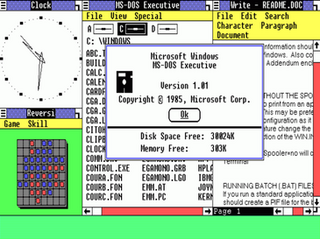 W
WWindows 1.0 is a graphical personal computer operating environment developed by Microsoft. Microsoft had worked with Apple Computer to develop applications for Apple's January 1984 original Macintosh, the first mass-produced personal computer with a graphical user interface (GUI) that enabled users to see user friendly icons on screen. Windows 1.0 was released on November 20, 1985, as the first version of the Microsoft Windows line. It runs as a graphical, 16-bit multi-tasking shell on top of an existing MS-DOS installation. It provides an environment which can run graphical programs designed for Windows, as well as existing MS-DOS software. Its development was spearheaded by the company founder Bill Gates after he saw a demonstration of a similar software suite known as Visi On at COMDEX.
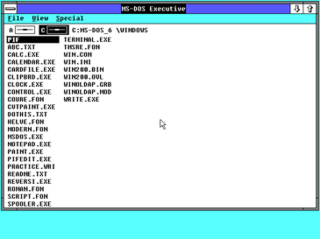 W
WWindows 2.0 is an obsoleted 16-bit Microsoft Windows GUI-based operating environment that was released on December 9, 1987, and the successor to Windows 1.0.
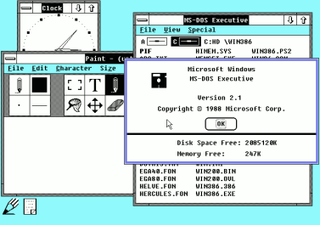 W
WWindows 2.1x is a historical version of Windows graphical user interface-based operating systems.
 W
WWindows 3.0 is the third major release of Microsoft Windows, launched in 1990. Like its predecessors, it is not an operating system, but rather a graphical operating environment that runs on top of DOS. It features a new graphical user interface (GUI) where applications are represented as clickable icons, as opposed to the list of file names seen in its predecessors. Later updates would expand the software's capabilities, one of which added multimedia support for sound recording and playback, as well as support for CD-ROMs.
 W
WWindows 3.1 is a series of obsolete 16-bit operating environments produced by Microsoft for use on personal computers, released on April 6, 1992. The series began with Windows 3.1, which was first sold during April 1992 as a successor to Windows 3.0. Subsequent versions were released between 1992 and 1993, notably Windows 3.11, until the series was superseded by the Windows 9x series starting in 1995 with Windows 95. During its lifespan, Windows 3.1 introduced several enhancements to the still MS-DOS-based platform, including improved system stability, expanded support for multimedia, TrueType fonts, and workgroup networking.
 W
WWindows 3.1 is a series of obsolete 16-bit operating environments produced by Microsoft for use on personal computers, released on April 6, 1992. The series began with Windows 3.1, which was first sold during April 1992 as a successor to Windows 3.0. Subsequent versions were released between 1992 and 1993, notably Windows 3.11, until the series was superseded by the Windows 9x series starting in 1995 with Windows 95. During its lifespan, Windows 3.1 introduced several enhancements to the still MS-DOS-based platform, including improved system stability, expanded support for multimedia, TrueType fonts, and workgroup networking.
 W
WWindows 9x is a generic term referring to a series of Microsoft Windows computer operating systems produced from 1995 to 2000, which were based on the Windows 95 kernel and its underlying foundation of MS-DOS, both of which were updated in subsequent versions. The first version in the 9x series was Windows 95, which was succeeded by Windows 98 and then Windows Me, which was the last version of Windows on the 9x line.
 W
WWindows 95 is a consumer-oriented operating system developed by Microsoft as part of its Windows 9x family of operating systems. The first operating system in the 9x family, it is the successor to Windows 3.1x, and was released to manufacturing on August 15, 1995, and generally to retail on August 24, 1995. Windows 95 merged Microsoft's formerly separate MS-DOS and Microsoft Windows products, and featured significant improvements over its predecessor, most notably in the graphical user interface (GUI) and in its simplified "plug-and-play" features. There were also major changes made to the core components of the operating system, such as moving from a mainly cooperatively multitasked 16-bit architecture to a 32-bit preemptive multitasking architecture, at least when running only 32-bit protected mode applications.
 W
WWindows 98 is an operating system developed by Microsoft as part of its Windows 9x family of Microsoft Windows operating systems. It is the successor to Windows 95, and was released to manufacturing on May 15, 1998, and generally to retail on June 25, 1998. Like its predecessor, it is a hybrid 16-bit and 32-bit monolithic product with the boot stage based on MS-DOS.
 W
WA stop error or exception error, commonly called the blue screen of death (BSoD) or blue screen, is an error screen displayed on Windows computers following a fatal system error. It indicates a system crash, in which the operating system has reached a condition where it can no longer operate safely. This is caused by many different problems, such as a general hardware failure or a crucial process terminating unexpectedly.
 W
WWindows IoT, formerly Windows Embedded, is a family of operating systems from Microsoft designed for use in embedded systems. Microsoft currently has three different subfamilies of operating systems for embedded devices targeting a wide market, ranging from small-footprint, real-time devices to point of sale (POS) devices like kiosks. Windows Embedded operating systems are available to original equipment manufacturers (OEMs), who make it available to end users preloaded with their hardware, in addition to volume license customers in some cases.
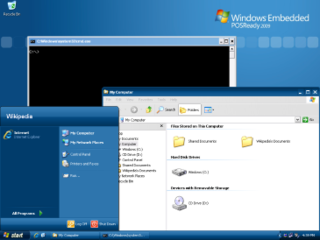 W
WWindows Embedded Industry, formerly Windows Embedded POSReady and Windows Embedded for Point of Service (WEPOS), is an operating system subfamily developed by Microsoft as part of its Windows Embedded family of products. Based on Windows NT, Windows Embedded Industry is designed for use in industrial devices such as cash registers, automated teller machines, and self service checkouts. Windows Embedded 8.1 Industry was the last release, with Windows 10 IoT Enterprise superseding Windows Embedded Industry, Windows Embedded Standard, and Windows For Embedded Systems (FES).
 W
WWindows 3.1 is a series of obsolete 16-bit operating environments produced by Microsoft for use on personal computers, released on April 6, 1992. The series began with Windows 3.1, which was first sold during April 1992 as a successor to Windows 3.0. Subsequent versions were released between 1992 and 1993, notably Windows 3.11, until the series was superseded by the Windows 9x series starting in 1995 with Windows 95. During its lifespan, Windows 3.1 introduced several enhancements to the still MS-DOS-based platform, including improved system stability, expanded support for multimedia, TrueType fonts, and workgroup networking.
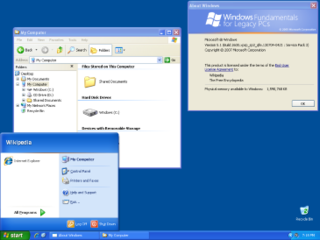 W
WWindows Fundamentals for Legacy PCs ("WinFLP") is a thin client operating system from Microsoft, based on Windows XP Embedded and is optimized for older, less powerful hardware. It was released on July 8, 2006 and is not marketed as a full-fledged general purpose operating system, although it is functionally able to perform most of the tasks generally associated with one. It includes only certain functionality for local workloads such as security, management, document viewing related tasks and the .NET Framework. It is designed to work as a client–server solution with RDP clients or other third party clients such as Citrix ICA.
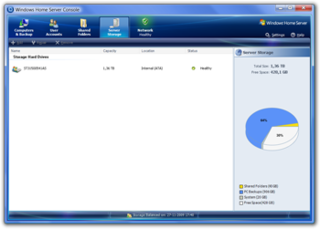 W
WWindows Home Server is a home server operating system from Microsoft. It was announced on 7 January 2007 at the Consumer Electronics Show by Bill Gates, released to manufacturing on 16 July 2007 and officially released on 4 November 2007.
 W
WWindows Millennium Edition, or Windows Me, is a graphical operating system developed by Microsoft as part of its Windows 9x family of operating systems. It is the successor to Windows 98 Second Edition (SE), and was released to manufacturing on June 19, 2000, with general availability on September 14, 2000.
 W
WMicrosoft Mobile was a subsidiary of Microsoft involved in the development and manufacturing of mobile phones. Based in Espoo, Finland, it was established in 2014 following the acquisition of Nokia's Devices and Services division by Microsoft in a deal valued at €5.4 billion, which was completed in April 2014. Nokia's then-CEO, Stephen Elop, joined Microsoft as president of its Devices division following the acquisition, and the acquisition was part of Steve Ballmer's strategy to turn Microsoft into a "devices and services" company. Under a 10-year licensing agreement, Microsoft Mobile held rights to sell feature phones running the S30+ platform under the Nokia brand.
 W
WMicrosoft PowerToys is a set of freeware system utilities designed for power users developed by Microsoft for use on the Windows operating system. These programs add or change features to maximize productivity or add more customization. PowerToys are available for Windows 95, Windows XP, and Windows 10. The PowerToys for Windows 10 are free and open-source software licensed under the MIT License and hosted on GitHub.
 W
WWindows Nashville was the codename for a cancelled release of Microsoft Windows scheduled to be released in 1996, between "Chicago" and "Memphis", causing it to be referred to as Windows 96 by the public. The release intended to focus on a tighter integration between Windows and Internet Explorer, in order to better compete with Netscape Navigator.
 W
WNeptune was the codename for a version of Microsoft Windows under development in 1999. Based on Windows 2000, it was to replace the Windows 9x series and was scheduled to be the first consumer version of Windows built on Windows NT code.
 W
WA paned window is a windows in a graphical user interface that has multiple parts, layers, or sections. Examples of this include a code browser in a typical integrated development environment; a file browser with multiple panels; or a web page that contains multiple frames. Simple console applications use an edit pane for accepting input and an output pane for displaying output.
 W
WWindows for Pen Computing is a software suite for Windows 3.1x, that Microsoft designed to incorporate pen computing capabilities into the Windows operating environment. Windows for Pen Computing was the second major pen computing platform for x86 tablet PCs; GO Corporation released their operating system, PenPoint OS, shortly before Microsoft published Windows for Pen Computing 1.0 in 1992.
 W
WWindows Preinstallation Environment is a lightweight version of Windows used for the deployment of PCs, workstations, and servers, or troubleshooting an operating system while it is offline. It is intended to replace MS-DOS boot disks and can be booted via USB flash drive, PXE, iPXE, CD-ROM, or hard disk. Traditionally used by large corporations and OEMs, it is now widely available free of charge via Windows Assessment and Deployment Kit (WADK).
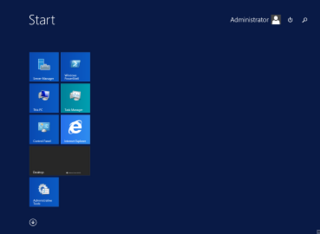 W
WWindows Server 2012 R2 is the sixth version of the Windows Server server operating system by Microsoft, as part of the Windows NT family of operating systems. It was unveiled on June 3, 2013 at TechEd North America, and released on October 18 of the same year.